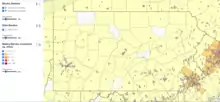Plug-in electric vehicles in Pennsylvania
In recent years, the popularity of electric vehicles (EVs) has increased dramatically, as numerous manufacturers now have vehicles competing in the US EV market. The state of Pennsylvania has focused some legislation on the spread of EVs as it plans to further decrease its carbon emissions in the transportation sector. Infrastructure updates including fast charging stations, sales and tax incentives are being rolled out to help facilitate this growth. In addition, there are also some alternatives to EV's that are more fuel efficient than traditional gasoline powered vehicles.
Statistics

Transportation contributes around one quarter of all greenhouse gas emissions and one third nitrogen oxide emission. If Pennsylvania adopts the Zero Emission Vehicle Program with a 100% electric vehicle goal, it is possible to cut carbon emissions down from light duty vehicles and trucks by 75% in 2050, or “by nearly two-thirds compared to a business-as-usual scenario with limited electrification after 2026”.[1] According to a study from February 2021, Pennsylvania ranks as the 17th best state in terms of electric vehicle adoption.[2] [3]As of May 2019, there are 14 alternative fuel corridors, which allow for electric vehicle charging, on 1,763 miles of highway.[4] The electric vehicle presence in the state is concentrated to the Southeast, around Philadelphia. 29,0000 electric vehicle were registered in November 2020, more than double the amount was registered in December 2017. The popularity of electric vehicles has been growing in Pennsylvania over the past decade, with sales topping 4,000 battery electric vehicles in 2018. A further 2,400 vehicles were purchased in 2019 under the DEP Alternative Fuel Vehicles Rebate Program and 850 level two fast chargers have been funded by the DEP Driving PA Forward program, with 11 future projects that plan to install more than 25 DC fast chargers.[5]
.jpg.webp)
Infrastructure
There are two types of plugs in Pennsylvania: public plugs accessible to the general public with 1,355 level 2 charging, and 114 DC fast charging, making 1,469. Tesla has 451 plugs that are only available to Tesla Drivers, with 241 being Level 2 charging and 210 being DC fast charging.[5] There can be some confusion when speaking about DC fasting charging and level 1 and level 2 charging. They can be broken down into DC fasting charging, which is the fastest charging system, and Level 1 and 2, which recharge significantly slower. Level 1 charges at about 3-5 driving miles per hour, Level 2 charges at about 10-25 driving miles per hour of order, and with DC fast charging you can get about 100–250 miles of range with only charging for about 30 mins.[5] Pennsylvania's EV are growing at a steady rate with plans on growing the amount of chargers to support that demand. Government grants are allowing a focuses on DC fast charging as this is key factor in making EV's more practical.
Sales Incentives
Pennsylvania and some other US states have signed an intent to facilitate a reduction in carbon emissions and a cleaner transportation sector. There are significant rebates offered to companies, businesses and residents to help make the switch to alternative fuel, the specifics of which are outlined by the Alternative Fuel Vehicle Rebate Guidelines.[6] There are rebates available to not only new vehicles, but also pre owned if the application is completed within 6 months of purchase. Outside of consumer vehicles, rebates for state owned vehicles such as school/transit buses are provided for by the Volkswagen Clean Air Act Civil Settlement.[7] There are significant rebates offered for purchasing charging ports that are made available to the public as well. These incentives don't only cover electric vehicles and hybrids, however, but also hydrogen cell, propane, and natural gas powered vehicles.[8]
Taxes
Electricity used in electric vehicles in Pennsylvania is subject to a proportional gas tax.[9] This is due to the Alternative Fuels Tax. The Alternative Fuels Tax is a tax on non-gasoline fuel sources that are used to power cars on state highways. This is to compensate for the lost revenue from electric vehicles not paying into the gasoline tax. Dealer-Users of alternative fuels are required in Pennsylvania to collect this tax on all applicable fuel sources. The tax rate on fuels covered by this fuels tax is based on the oil company franchise tax. The tax rate is calculated by proportionally using the gasoline tax rate to charge an equivalent amount per energy content of the electricity.[10] The current tax rate for 2021 is $0.0172 per Kilowatt Hour (KWH) of electricity.[11]
References
- "Cleaner Cars for PA". pennenvironment.org. Retrieved September 23, 2021.
- "Pennsylvania ranks 17th among states gearing up for shift to electric vehicles". StateImpact Pennsylvania. February 3, 2021. Retrieved September 23, 2021.
- "ACEEE State Transportation Electrification Scorecard". www.aceee.org. Retrieved March 21, 2022.
- "Article Viewer". www.ahs.dep.pa.gov. Retrieved September 23, 2021.
- "files.dep.state.pa.us - /Energy/OfficeofPollutionPrevention/StateEnergyProgram/". files.dep.state.pa.us. Retrieved September 16, 2021.
- "Alternative Fuels Data Center: Pennsylvania Laws and Incentives". afdc.energy.gov. Retrieved September 23, 2021.
- US EPA, OECA (February 13, 2019). "Volkswagen Clean Air Act Civil Settlement". www.epa.gov. Retrieved September 23, 2021.
- "Alternative Fuel Vehicles". Department of Environmental Protection. Retrieved September 23, 2021.
- "Alternative Fuels Tax". Pennsylvania Department of Revenue. Retrieved September 16, 2021.
- "The Tax Compendium April 2021" (PDF). Pennsylvania Department of Revenue. Retrieved September 23, 2021.
{{cite web}}: CS1 maint: url-status (link) - "Alternative Fuels Tax Rates". Pennsylvania Department of Revenue. Retrieved September 23, 2021.